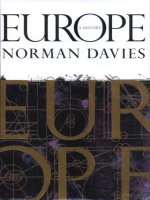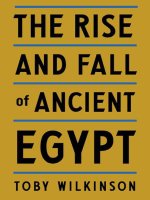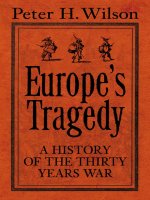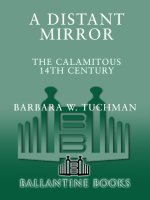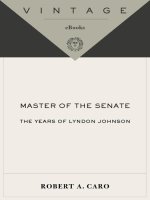Dava sobel galileos daughter a historic ove (v5 0)
Bạn đang xem bản rút gọn của tài liệu. Xem và tải ngay bản đầy đủ của tài liệu tại đây (5.91 MB, 257 trang )
DAVA SOBEL
GALILEO’S
DAUGHTER
A Historical
Memoir of Science,
faith, and love
CONTENTS
PART ONE. TO FLORENCE
[I] She who was so precious to you
[II] This grand book the universe
[III] Bright stars speak of your virtues
[IV] To have the truth seen and recognized
[V] In the very face of the sun
[VI] Observant executrix of God’s commands
[VII] The malice of my persecutors
[VIII] Conjecture here among shadows
PART TWO. ON BELLOSGUARDO
[IX] How our father is favored
[X] To busy myself in your service
[XI] What we require above all else
[XII] Because of our zeal
[XIII] Through my memory of their eloquence
[XIV] A small and trifling body
[XV] On the right path, by the grace of god
[XVI] The tempest of our many torments
PART THREE. IN ROME
[XVII] While seeking to immortalize your fame
[XVIII] Since the lord chastises us with these whips
[XIX] The hope of having you always near
[XX] That I should be begged to publish such a work
PART FOUR. IN CARE OF THE TUSCAN EMBASSY,VILLA MEDICI, ROME
[XXI] How anxiously I live, awaiting word from you
[XXII] In the chambers of the Holy office of the inquisition
[XXIII] Vainglorious ambition, pure ignorance, and inadvertence
[XXIV] Faith vested in the miraculous Madonna of Impruneta
[XXV] Judgment passed on your book and your person
PART FIVE. AT SIENA
[XXVI] Not knowing how to refuse him the keys
[XXVII] Terrible destruction on the feast of San Lorenzo
[XXVIII] Recitation of the penitential psalms
[XXIX] The book of life, or, A prophet accepted in his own land
PART SIX. FROM ARCETRI
[XXX] My soul and its longing
[XXXI]Until I have this from your lips
[XXXII] As I struggle to understand
[XXXIII] The memory of the sweetnesses
In Galileo’s Time
Florentine Weights, Measures, Currency
Notes
EndNotes
Bibliography
Appreciation
Art Credits
To the fathers,
Galileo Galilei
&
Samuel Hillei Sobel, M.D.
in loving memory.
Italy in 1603
PART ONE
To
Florence
[I]
She who was
so precious
to you
MOST ILLUSTRIOUS LORD FATHER
We are terribly saddened by the death of your cherished sister, our dear aunt; but our sorrow at losing
her is as nothing compared to our concern for your sake, because your suffering will be all the
greater, Sire, as truly you have no one else left in your world, now that she, who could not have been
more precious to you, has departed, and therefore we can only imagine how you sustain the severity
of such a sudden and completely unexpected blow. And while I tell you that we share deeply in your
grief, you would do well to draw even greater comfort from contemplating the general state of human
misery, since we are all of us here on Earth like strangers and wayfarers, who soon will be bound for
our true homeland in Heaven, where there is perfect happiness, and where we must hope that your
sister’s blessed soul has already gone. Thus, for the love of God, we pray you, Sire, to be consoled
and to put yourself in His hands, for, as you know so well, that is what He wants of you; to do
otherwise would be to injure yourself and hurt us, too, because we lament grievously when we hear
that you are burdened and troubled, as we have no other source of goodness in this world but you.
I will say no more, except that with all our hearts we fervently pray the Lord to comfort you and be
with you always, and we greet you dearly with our ardent love.
FROM SAN MATTEO, THE 10TH DAY OF MAY 1623.
Most affectionate daughter,
The day after his sister Virginia’s funeral, the already world-renowned scientist Galileo Galilei
received this, the first of 124 surviving letters from the once-voluminous correspondence he carried
on with his elder daughter. She alone of Galileo’s three children mirrored his own brilliance,
industry, and sensibility, and by virtue of these qualities became his confidante.
Galileo’s daughter, born of his long illicit liaison with the beautiful Marina Gamba of Venice,
entered the world in the summer heat of a new century, on August 13, 1600—the same year the
Dominican friar Giordano Bruno was burned at the stake in Rome for insisting, among his many
heresies and blasphemies, that the Earth traveled around the Sun, instead of remaining motionless at
the center of the universe. In a world that did not yet know its place, Galileo would engage this same
cosmic conflict with the Church, treading a dangerous path between the Heaven he revered as a good
Catholic and the heavens he revealed through his telescope.
Galileo christened his daughter Virginia, in honor of his “cherished sister.” But because he never
married Virginia’s mother, he deemed the girl herself unmarriageable. Soon after her thirteenth
birthday, he placed her at the Convent of San Matteo in Arcetri, where she lived out her life in
poverty and seclusion.
Virginia adopted the name Maria Celeste when she became a nun, in a gesture that acknowledged
her father’s fascination with the stars. Even after she professed a life of prayer and penance, she
remained devoted to Galileo as though to a patron saint. The doting concern evident in her
condolence letter was only to intensify over the ensuing decade as her father grew old, fell more
frequently ill, pursued his singular research nevertheless, and published a book that brought him to
trial by the Holy Office of the Inquisition.
The “we” of Suor Maria Celeste’s letter speaks for herself and her sister, Livia—Galileo’s strange,
silent second daughter, who also took the veil and vows at San Matteo to become Suor Arcangela.
Meanwhile their brother, Vincenzio, the youngest child of Galileo and Marina’s union, had been
legitimized in a fiat by the grand duke of Tuscany and gone off to study law at the University of Pisa.
Handmade telescope by Galileo
Thus Suor Maria Celeste consoled Galileo for being left alone in his world, with daughters
cloistered in the separate world of nuns, his son not yet a man, his former mistress dead, his family of
origin all deceased or dispersed.
Galileo, now fifty-nine, also stood boldly alone in his world-view, as Suor Maria Celeste knew
from reading the books he wrote and the letters he shared with her from colleagues and critics all
over Italy, as well as from across the continent beyond the Alps. Although her father had started his
career as a professor of mathematics, teaching first at Pisa and then at Padua, every philosopher in
Europe tied Galileo’s name to the most startling series of astronomical discoveries ever claimed by a
single individual.
In 1609, when Suor Maria Celeste was still a child in Padua, Galileo had set a telescope in the
garden behind his house and turned it skyward. Never-before-seen stars leaped out of the darkness to
enhance familiar constellations; the nebulous Milky Way resolved into a swath of densely packed
stars; mountains and valleys pockmarked the storied perfection of the Moon; and a retinue of four
attendant bodies traveled regularly around Jupiter like a planetary system in miniature.
“I render infinite thanks to God,” Galileo intoned after those nights of wonder, “for being so kind as
to make me alone the first observer of marvels kept hidden in obscurity for all previous centuries.”
The newfound worlds transformed Galileo’s life. He won appointment as chief mathematician and
philosopher to the grand duke in 1610, and moved to Florence to assume his position at the court of
Cosimo de’ Medici. He took along with him his two daughters, then ten and nine years old, but he left
Vincenzio, who was only four when greatness descended on the family, to live a while longer in
Padua with Marina.
Galileo found himself lionized as another Columbus for his conquests. Even as he attained the
height of his glory, however, he attracted enmity and suspicion. For instead of opening a distant land
dominated by heathens, Galileo trespassed on holy ground. Hardly had his first spate of findings
stunned the populace of Europe before a new wave followed: He saw dark spots creeping
continuously across the face of the Sun, and “the mother of loves,” as he called the planet Venus,
cycling through phases from full to crescent, just as the Moon did.
All his observations lent credence to the unpopular Sun-centered universe of Nicolaus Copernicus,
which had been introduced over half a century previously, but foundered on lack of evidence.
Galileo’s efforts provided the beginning of a proof. And his flamboyant style of promulgating his
ideas—sometimes in bawdy humorous writings, sometimes loudly at dinner parties and staged
debates—transported the new astronomy from the Latin Quarters of the universities into the public
arena. In 1616, a pope and a cardinal inquisitor reprimanded Galileo, warning him to curtail his
forays into the supernal realms. The motions of the heavenly bodies, they said, having been touched
upon in the Psalms, the Book of Joshua, and elsewhere in the Bible, were matters best left to the Holy
Fathers of the Church.
Galileo obeyed their orders, silencing himself on the subject. For seven cautious years he turned his
efforts to less perilous pursuits, such as harnessing his Jovian satellites in the service of navigation,
to help sailors discover their longitude at sea. He studied poetry and wrote literary criticism.
Modifying his telescope, he developed a compound microscope. “I have observed many tiny animals
with great admiration,” he reported, “among which the flea is quite horrible, the gnat and the moth
very beautiful; and with great satisfaction I have seen how flies and other little animals can walk
attached to mirrors, upside down.”
Shortly after his sister’s death in May of 1623, however, Galileo found reason to return to the Suncentered universe like a moth to a flame. That summer a new pope ascended the throne of Saint Peter
in Rome. The Supreme Pontiff Urban VIII brought to the Holy See an intellectualism and an interest in
scientific investigation not shared by his immediate predecessors. Galileo knew the man personally—
he had demonstrated his telescope to him and the two had taken the same side one night in a debate
about floating bodies after a banquet at the Florentine court. Urban, for his part, had admired Galileo
so long and well that he had even written a poem for him, mentioning the sights revealed by
“Galileo’s glass.”
Ptolemy’s Earth-centered system of the world
The presence of the poet pope encouraged Galileo to proceed with a long-planned popular
dissertation on the two rival theories of cosmology: the Sun-centered and the Earth-centered, or, in
his words, the “two chief systems of the world.”
It might have been difficult for Suor Maria Celeste to condone this course—to reconcile her role as
a bride of Christ with her father’s position as potentially the greatest enemy of the Catholic Church
since Martin Luther. But instead she approved of his endeavors because she knew the depth of his
faith. She accepted Galileo’s conviction that God had dictated the Holy Scriptures to guide men’s
spirits but proffered the unraveling of the universe as a challenge to their intelligence. Understanding
her father’s prodigious capacity in this pursuit, she prayed for his health, for his longevity, for the
fulfillment of his “every just desire.” As the convent’s apothecary, she concocted elixirs and pills to
strengthen him for his studies and protect him from epidemic diseases. Her letters, animated by her
belief in Galileo’s innocence of any heretical depravity, carried him through the ordeal of his ultimate
confrontation with Urban and the Inquisition in 1633.
Copernicus’s Sun-centered system of the world
No detectable strife ever disturbed the affectionate relationship between Galileo and his daughter.
Theirs is not a tale of abuse or rejection or intentional stifling of abilities. Rather, it is a love story, a
tragedy, and a mystery.
Most of Suor Maria Celeste’s letters traveled in the pocket of a messenger, or in a basket laden
with laundry, sweetmeats, or herbal medicines, across the short distance from the Convent of San
Matteo, on a hillside just south of Florence, to Galileo in the city or at his suburban home. Following
the angry papal summons to Rome in 1632, however, the letters rode on horseback some two hundred
miles and were frequently delayed by quarantines imposed as the Black Plague spread death and
dread across Italy. Gaps of months’ duration disrupt the continuity of the reportage in places, but
every page is redolent of daily life, down to the pain of toothache and the smell of vinegar.
Galileo held on to his daughter’s missives indiscriminately, collecting her requests for fruits or
sewing supplies alongside her outbursts on ecclesiastical politics. Similarly, Suor Maria Celeste
saved all of Galileo’s letters, as rereading them, she often reminded him, gave her great pleasure. By
the time she received the last rites, the letters she had gathered over her lifetime in the convent
constituted the bulk of her earthly possessions. But then the mother abbess, who would have
discovered Galileo’s letters while emptying Suor Maria Celeste’s cell, apparently buried or burned
them out of fear. After the celebrated trial at Rome, a convent dared not harbor the writings of a
“vehemently suspected” heretic. In this fashion, the correspondence between father and daughter was
long ago reduced to a monologue.
Standing in now for all the thoughts he once expressed to her are only those he chanced to offer
others about her. “A woman of exquisite mind,” Galileo described her to a colleague in another
country, “singular goodness, and most tenderly attached to me.”
On first learning of Suor Maria Celeste’s letters, people generally assume that Galileo’s replies
must lie concealed somewhere in the recesses of the Vatican Library, and that if only an enterprising
outsider could gain access, the missing half of the dialogue would be found. But, alas, the archives
have been combed, several times, by religious authorities and authorized researchers all desperate to
hear the paternal tone of Galileo’s voice. These seekers have come to accept the account of the
mother abbess’s destruction of the documents as the most reasonable explanation for their
disappearance. The historical importance of any paper signed by Galileo, not to mention the prices
such articles have commanded for the past two centuries, leaves few conceivable places where
whole packets of his letters could hide.
Although numerous commentaries, plays, poems, early lectures, and manuscripts of Galileo’s have
also disappeared (known only by specific mentions in more than two thousand preserved letters from
his contemporary correspondents), his enormous legacy includes his five most important books, two
of his original handmade telescopes, various portraits and busts he sat for during his lifetime, even
parts of his body preserved after death. (The middle finger of his right hand can be seen, encased in a
gilded glass egg atop an inscribed marble pedestal at the Museum of the History of Science in
Florence.)
Of Suor Maria Celeste, however, only her letters remain. Bound into a single volume with
cardboard and leather covers, the frayed, deckle-edged pages now reside among the rare manuscripts
at Florence’s National Central Library. The handwriting throughout is still legible, though the onceblack ink has turned brown. Some letters bear annotations in Galileo’s own hand, for he occasionally
jotted notes in the margins about the things she said and at other times made seemingly unrelated
calculations or geometric diagrams in the blank spaces around his address on the verso. Several of
the sheets are marred by tiny holes, torn, darkened by acid or mildew, smeared with spilled oil. Of
those that are water-blurred, some obviously ventured through the rain, while others look more likely
tear-stained, either during the writing or the reading of them. After nearly four hundred years, the red
sealing wax still sticks to the folded corners of the paper.
These letters, which have never been published in translation, recast Galileo’s story. They recolor
the personality and conflict of a mythic figure, whose seventeenth-century clash with Catholic
doctrine continues to define the schism between science and religion. For although science has soared
beyond his quaint instruments, it is still caught in his struggle, still burdened by an impression of
Galileo as a renegade who scoffed at the Bible and drew fire from a Church blind to reason.
This pervasive, divisive power of the name Galileo is what Pope John Paul II tried to tame in 1992
by reinvoking his torment so long after the fact. “A tragic mutual incomprehension,” His Holiness
observed of the 350-year Galileo affair, “has been interpreted as the reflection of a fundamental
opposition between science and faith.”
Yet the Galileo of Suor Maria Celeste’s letters recognized no such division during his lifetime. He
remained a good Catholic who believed in the power of prayer and endeavored always to conform
his duty as a scientist with the destiny of his soul. “Whatever the course of our lives,” Galileo wrote,
“we should receive them as the highest gift from the hand of God, in which equally reposed the power
to do nothing whatever for us. Indeed, we should accept misfortune not only in thanks, but in infinite
gratitude to Providence, which by such means detaches us from an excessive love for Earthly things
and elevates our minds to the celestial and divine.”
[II]
This grand book
the universe
The recently deceased relative Suor Maria Celeste mourned in her first extant letter was Virginia
Galilei Landucci, the aunt she’d been named after. At the Convent of San Matteo, she shared her grief
with her natural sister, Suor Arcangela (originally the namesake of Galileo’s other sister, Livia), and
also with her cousin Suor Chiara—the departed Virginia’s own daughter Virginia.
A repetition of recollected identities echoed through the Galilei family like the sound of chanting,
with its most melodic expression in the poetic rhythm of the great scientist’s full name. By accepted
practice among established Tuscan families in the mid-sixteenth century, when Galileo was born, the
eldest son might well receive a Christian name derived from his parents’ surname. Accordingly,
Vincenzio Galilei and his new wife, Giulia Ammannati Galilei, attracted no special attention when
they gave the name Galileo to their first child, born at Pisa on the fifteenth day of February in the year
of our Lord 1564. (The year was actually recorded as 1563 in the chronicles of that period, however,
when New Year’s Day fell on March 25—the feast of the Annunciation.)
The family name Galilei, ironically, had itself been created from the first name of one of its
foremost favorite sons. This was the renowned doctor Galileo Buonaiuti, who taught and practiced
medicine during the early 1400s in Florence, where he also served the government loyally. His
descendants redubbed themselves the Galilei family in his honor and wrote “Galileo Galilei” on his
tombstone, but retained the coat of arms that had belonged to the ancestral Buonaiutis since the
thirteenth century—a red stepladder on a gold shield, forming a pictograph of the word buonaiuti,
which literally means “good help.” The meaning of the name Galileo, or Galilei, harks back to the
land of Galilee, although, as Galileo explained on this score, he was not at all a Jew.
GALILEI GENEALOGY
GALILEI FAMILY COAT OF ARMS
Galileo Galilei took a few tentative steps along his famous forebear’s path, studying medicine for
two years at the University of Pisa, before he gave himself over to the pursuit of mathematics and
physics, his true passion. “Philosophy is written in this grand book the universe, which stands
continually open to our gaze,” Galileo believed. “But the book cannot be understood unless one first
learns to comprehend the language and to read the alphabet in which it is composed. It is written in
the language of mathematics, and its characters are triangles, circles, and other geometric figures,
without which it is humanly impossible to understand a single word of it; without these, one wanders
about in a dark labyrinth.”
Galileo’s father had opposed the idea of his becoming a mathematician and tried, arguing from long
personal experience with mathematics and patrician poverty, to dissuade his son from choosing such
a poorly paid career.
Vincenzio made a minimal living giving music lessons in the rented Pisan house where Galileo was
born and partly raised. He also dabbled in the business dealings of his wife’s family, the Ammannati
cloth merchants, to supplement his small teaching income, but he was at heart a composer and musical
theorist in the days when musical theory was considered a special branch of mathematics. Vincenzio
taught Galileo to sing, and to play the organ and other instruments, including the recently remodeled
lute, which became their favorite. In the course of this instruction he introduced the boy to the
Pythagorean rule of musical ratios, which required strict obedience in tuning and composition to
numerical properties of notes in a scale. But Vincenzio subjected these prevailing rules to his own
studies on the physics of sound. Music, after all, arose from vibrations in the air, not abstract
concepts regarding whole numbers. Using this philosophy, Vincenzio established an ideal tuning
formula for the lute by fractionally shortening the intervals between successive frets.
After Vincenzio moved to Florence with his wife in 1572, temporarily leaving Galileo behind in the
care of relatives, he joined other virtuoso performers, scholars, and poets bent on reviving classic
Greek tragedy with music.* Vincenzio later wrote a book defending the new trend in tuning that
favored the sweetness of the instrument’s sound over the ancient adherence to strict numerical
relationships between notes. This book openly challenged Vincenzio’s own former music teacher,
who prevented its publication in Venice in 1578. Vincenzio persevered, however, until he saw the
work printed in Florence three years later. None of these lessons in determination or challenge to
authority was lost on the young Galileo.
“It appears to me,” Vincenzio stated in his Dialogue of Ancient and Modern Music, “that they who
in proof of any assertion rely simply on the weight of authority, without adducing any argument in
support of it, act very absurdly. I, on the contrary, wish to be allowed freely to question and freely to
answer you without any sort of adulation, as well becomes those who are in search of truth.”
When Galileo was ten, he journeyed across Tuscany to join his parents and his infant sister,
Virginia, in Florence. He attended grammar school near his new home until his thirteenth year, then
moved into the Benedictine monastery at Vallombrosa to take instruction in Greek, Latin, and logic.
Once there, he joined the order as a novice, hoping to become a monk himself, but his father wouldn’t
let him. Vincenzio withdrew Galileo and took him home, blaming an inflammation in the youth’s eyes
that required medical attention. Money more likely decided the issue, for Vincenzio could ill afford
the down payment and regular upkeep required to support his son in a religious vocation that
generated no income. A girl was different. Vincenzio would have to pay dowries for his daughters,
either to the Church or to a husband, and he could expect no return on either investment. Thus
Vincenzio needed Galileo to grow up gainfully employed, preferably as a doctor, so he could help
support his younger sisters, now four in number, and two brothers.
Vincenzio planned to send Galileo back to Pisa, to the College of the Sapienza, as one of forty
Tuscan boys awarded free tuition and board, but couldn’t obtain the necessary scholarship. A good
friend of Vincenzio’s in Pisa offered to take Galileo into his own home, to reduce the cost of the
boy’s education. Vincenzio, however, hearing that this friend was romancing one of Galileo’s
Ammannati cousins, held off for three years until the love affair ended in marriage and made the
house a respectable residence for his son.
In September of 1581, Galileo matriculated at the University of Pisa, where medicine and
mathematics both fit into the Faculty of Arts. Although he applied himself to the medical curriculum to
please his father, he much preferred mathematics from the moment he encountered the geometry of
Euclid in 1583. After four years of formal study, Galileo left Pisa in 1585, at age twenty-one, without
completing the course requirements for a degree.
Galileo returned to his father’s house in Florence. There he began behaving like a professional
mathematician—writing proofs and papers in geometry, going out to give occasional public lectures,
including two to the Florentine Academy on the conic configuration of Dante’s Inferno, and tutoring
private students. Between 1588 and 1589, when Vincenzio filled a room with weighted strings of
varying lengths, diameters, and tensions to test certain harmonic ideas, Galileo joined him as his
assistant. It seems safe to say that Galileo, who gets credit for being the father of experimental
physics, may have learned the rudiments and value of experimentation from his own father’s efforts.
Having impressed several established mathematicians with his talent, Galileo procured a teaching
post at the University of Pisa in 1589, and returned once more to the city of his birth at the mouth of
the River Arno. The flooding of the river in fact delayed Galileo’s arrival on campus, so that he
missed his first six lectures and found himself fined for these absences. By the end of the year, the
university authorities were docking his pay for a different sort of infraction: his refusal to wear the
regulation academic regalia at all times.
Galileo deemed official doctoral dress a pretentious nuisance, and he derided the toga in a threehundred-line verse spoof that enjoyed wide readership in that college town. Any kind of clothing got
in the way of men’s and women’s frank appraisals of each other’s attributes, he argued in ribald
rhyme, while professional uniforms hid the true merits of character under a cloak of social standing.
Worse, the dignity of the professor’s gown barred him from the brothel, denying him the evil
pleasures of whoring while resigning him to the equally sinful solace of his own hands. The gown
even impeded walking, to say nothing of working.
A long black robe would surely have hindered Galileo’s progress up the Leaning Tower’s eightstory spiral staircase, laden, as legend has it, with cannonballs to demonstrate a scientific principle.
In that infamous episode, the weight of iron on the twenty-five-year-old professor’s shoulders was as
nothing compared to the burden of Aristotelian thought on his students’ perceptions of reality. Not
only Galileo’s classes at Pisa, but university communities all over Europe, honored the dictum of
Aristotelian physics that objects of different weights fall at different speeds. A cannonball of ten
pounds, for example, would be expected to fall ten times faster than a musket ball of only one pound,
so that if both were released together from some summit, the cannonball would land before the musket
ball had gotten more than one-tenth of the way to the ground. This made perfect sense to most
philosophical minds, though the thought struck Galileo as preposterous. “Try, if you can,” Galileo
exhorted one of his many opponents, “to picture in your mind the large ball striking the ground while
the small one is less than a yard from the top of the tower.”
“Imagine them joining together while falling,” he appealed to another debater. “Why should they
double their speed as Aristotle claimed?" If the incongruity of these midair scenarios didn’t deflate
Aristotle’s ideas, it was a simple enough matter to test his assertions with real props in a public
setting.
Galileo never recorded the date or details of the actual demonstration himself but recounted the
story in his old age to a young disciple, who included it in a posthumous biographical sketch.
However dramatically Galileo may have executed the event, he did not succeed in swaying popular
opinion down at the base of the Leaning Tower. The larger ball, being less susceptible to the effects
of what Galileo recognized as air resistance, fell faster, to the great relief of the Pisan philosophy
department. The fact that it fell only fractionally faster gave Galileo scant advantage.
“Aristotle says that a hundred-pound ball falling from a height of a hundred braccia [arm lengths]
hits the ground before a one-pound ball has fallen one braccio. I say they arrive at the same time,”
Galileo resummarized the dispute in its aftermath. “You find, on making the test, that the larger ball
beats the smaller one by two inches. Now, behind those two inches you want to hide Aristotle’s
ninety-nine braccia and, speaking only of my tiny error, remain silent about his enormous mistake.”
Indeed this was the case. Many philosophers of the sixteenth century, unaccustomed to experimental
proof, much preferred the wisdom of Aristotle to the antics of Galileo, which made him an unpopular
figure at Pisa.
When Vincenzio died in 1591 at the age of seventy, Galileo assumed financial responsibility for the
whole family on a math professor’s meager salary of sixty scudi annually. (Professors in the more
venerated field of philosophy made six to eight times as much, while a father confessor could earn
close to two hundred scudi per year, a well-trained physician about three hundred, and the
commanders of the Tuscan armed forces between one thousand and twenty-five hundred.) Galileo
paid out dowry installments to his newly married sister Virginia’s fractious husband, Benedetto
Landucci, supported his mother and sixteen-year-old brother, Michelangelo, and maintained his sister
Livia at the Convent of San Giuliano until he could arrange for her to be wed. By this time, his three
other siblings had all died of childhood diseases.
Galileo lent his help ungrudgingly, even enthusiastically. “The present I am going to make Virginia
consists of a set of silken bed-hangings,” he had written home from Pisa just before her wedding. “I
bought the silk at Lucca, and had it woven, so that, though the fabric is of a wide width, it will cost
me only about three carlini [about one-hundredth of a scudo] the yard. It is a striped material, and I
think you will be much pleased with it. I have ordered silk fringes to match, and could very easily get
the bedstead made, too. But do not say a word to anyone, that it may come to her quite unexpectedly. I
will bring it when I come home for the Carnival holidays, and, as I said before, if you like I will
bring her worked velvet and damask, stuff enough to make four or five handsome dresses.”
In 1592, the year after he buried his father in the Florentine church called Santa Croce, Galileo left
Pisa for the chair of mathematics at the University of Padua. If he had to forsake his native Tuscany
for the Serene Republic of Venice, at least he enjoyed a more distinguished position there and
increased his income to 180 Venetian florins per year.
The University of Padua, where Galileo taught for eighteen years
From the perspective of old age, Galileo would describe his time in Padua as the happiest period of
his life. He made important friends with some of the republic’s great cultural and intellectual leaders,
who invited him to their homes as well as to consult on shipbuilding at the Venetian Arsenale. The
Venetian senate granted him a patent on an irrigation device he invented. Galileo’s influential
supporters and quick-spreading reputation as an electrifying lecturer earned him raises that pushed his
university salary to 300 and then to 480 florins annually. At Padua he also pursued the seminal studies
of the properties of motion that he had begun in Pisa, for wise men regarded motion as the basis of all
natural philosophy.
Fatefully during his Paduan idyll, while visiting friends outside the city, Galileo and two gentleman
companions escaped the midday heat one afternoon by taking a siesta in an underground room.
Natural air-conditioning cooled this chamber by means of a conduit that delivered wind from a
waterfall inside a nearby mountain cave. Such ingenious systems ventilated numerous sixteenthcentury villas in the Italian countryside but may have admitted some noxious vapors along with the
welcome zephyrs, as apparently occurred in Galileo’s case. When the men awoke from their twohour nap, they complained of various symptoms including cramps and chills, intense headache,
hearing loss, and muscle lethargy. Within days, the strange malaise proved fatal for one of its victims;
the second man lived longer but also died of the same exposure. Galileo alone recovered. For the rest
of his life, however, bouts of pain, later described by his son as arthritic or rheumatic seizures, would
strike him down and confine him to his bed for weeks on end.
Under happier circumstances—although no one knows precisely when or how—Galileo in Padua
met Marina Gamba, the woman who shared his private hours for twelve years and bore him three
children.
Marina did not share his house, however. Galileo dwelled on Padua’s Borgo dei Vignali (renamed,
in recent times, Via Galileo Galilei). Like most professors, he rented out rooms to private students,
many of them young noblemen from abroad, who paid to board under his roof for the duration of their
private lessons with him. Marina lived in Venice, where Galileo traveled by ferry on the weekends to
enjoy himself. When she became pregnant, he moved her to Padua, to a small house on the Ponte
Corvo, only a five-minute walk away from his own (if one could have counted minutes in those days).
Even after the ties between Marina and Galileo were strengthened by the growth of their family, their
separate living arrangement remained the same.
Suor Maria Celeste Galilei, nee “Virginia, daughter of Marina from Venice,” was “born of
fornication,” that is to say, out of wedlock, according to the parish registry of San Lorenzo in the city
of Padua, on the thirteenth of August 1600, and baptized on the twenty-first. Marina was twenty-two
on this occasion, and Galileo (though no mention divulges his identity), thirty-six. Such age
discrepancies occurred commonly among couples at that time. Galileo’s own father had reached
forty-two years before taking the twenty-four-year-old Giulia as his bride.
Engraving of Galileo at age thirty-eight, by Joseph Calendi
The following year, 1601, again in August, a registry entry on the twenty-seventh marked the
baptism of “Livia Antonia, daughter of Marina Gamba and of—” followed by a blank space.
After five more years, on August 22, 1606, a third child was baptized, “Vincenzio Andrea, son of
Madonna Marina, daughter of Andrea Gamba, and an unknown father.” Technically an “unknown
father” for being unmarried to the mother, Galileo nevertheless asserted his paternity by giving the
baby both grandfathers’ names.
Galileo recognized his illegitimate children as the heirs of his lineage, and their mother as his mate,
although he ever avoided marrying Marina. Scholars by tradition tended to remain single, and the
notations in the parish registry hint at circumstances that would have strengthened Galileo’s resolve.
After all, she was “Marina from Venice"—not from Pisa or Florence, or Prato or Pistoia, or any other
town within the bounds of Tuscany, where Galileo determined to return someday. And her heritage,
“daughter of Andrea Gamba,” did not put her on a par with the poor but patrician Galilei family,
whose ancestors had signed their names in the record books of a great city government.
[III]
Bright stars
speak of
your virtues
As his paduan career increased its brilliance in the early years of the seventeenth century, Galileo
continued struggling to meet all his expensive family responsibilities. In 1600 his younger brother, the
musical Michelangelo, was invited to play at the court of a Polish prince, and despite the maturity of
his twenty-five years, he tapped Galileo for the clothing and money he needed to make the trip. Also
in 1600, the same year Galileo saw the birth of his daughter Virginia, he found a husband for his
sister Livia. Upon her marriage to Taddeo Galletti in 1601, Galileo negotiated the dowry, paid for the
ceremony and the wedding feast, and also bought Livia’s dress, which was made of black Naples
velvet with light blue damask that cost more than one hundred scudi. Then, in 1608, Michelangelo got
married, moved to Germany, and reneged on his promised share of the sisters’ dowry contracts,
precipitating a legal action by brother-in-law Benedetto Landucci, who complained of being cheated
out of his expected sum.
Fortunately, Galileo’s endeavors led him to a new source of supplemental income. In the course of
teaching military architecture and fortification to private students, he had invented his first
commercial scientific instrument in 1597, called the geometric and military compass. It looked like a
pair of metal rulers joined by a pivot, covered all over by numbers and scales, with screws and an
attachable arch to hold the compass arms open at almost any angle. By 1599, after various
modifications, the device functioned as an early pocket calculator that could compute compound
interest or monetary exchange rates, extract square roots for arranging armies on the battlefield, and
determine the proper charge for any size cannon. Shipwrights at the nearby Venetian Arsenale also
adopted Galileo’s revolutionary compass, to help them execute and test new hull designs in scale
models before building them full-size.
Galileo crafted the first few compasses himself but soon required the services of a full-time, live-in
instrument maker to meet the popular demand. The hired craftsman moved into Galileo’s house with
wife and children in tow, to work in exchange for salary, room and board for his whole family, all
production materials, and a two-thirds share of the price of finished brass instruments, which sold for
five scudi each. Galileo would not have made much money under these conditions, except that he
charged every visiting student nearly twenty scudi to learn how to use the compass, and all of this
was his to keep. At first he gave out a personally handwritten instruction manual as a learning aid;
then in 1603 he hired an amanuensis to help generate enough copies— until three years later, when he
hit on the idea of publishing the booklet for sale with the instrument.
He called his treatise Operations of the Geometric and Military Compass of Galileo Galilei,
Florentine Patrician and Teacher of Mathematics in the University of Padua. Its 1606 title page
notes that the book was printed “in the Author’s House” and cannily dedicated to the future grand
duke of Tuscany, Don Cosimo de’ Medici.
Galileo’s geometric and military compass
“If, Most Serene Prince,” Galileo addressed his young patron in the dedication, “I wished to set
forth in this place all the praises due to your Highness’s own merits and those of your distinguished
family, I should be committed to such a lengthy discourse that this preface would far outrun the rest of
the text, whence I shall refrain from even attempting that task, uncertain that I could finish half of it, let
alone all.”
Cosimo, a lad of sixteen, had become Galileo’s most elite private pupil the previous summer. The
heir apparent to the House of Medici, he bore the name of his resolute grandfather, Cosimo I, who had
expelled all rival and foreign influences from Florence, annexed the city of Siena to the Duchy of
Tuscany, and then pressured Pope Pius V to create for him the title of grand duke in 1569. Thus the
self-made Medici family, who had been successful bankers holding high government positions in the
old Republic of Florence throughout the fourteenth and fifteenth centuries, assumed the aura and
authority of royalty in Galileo’s time.
Medici coat or arms
Galileo, who typically returned to Florence when the University at Padua closed between terms,
procured recommendations as a mathematical mentor to the royal household. As young Prince
Cosimo’s tutor, Galileo gained status with the boy’s powerful parents: the much beloved Grand Duke
Ferdinando I (who had started his career as a cardinal in Rome before being called home to the
throne at the sudden death of his lecherous, murderous older brother, Francesco) and his devoutly
religious French wife, Grand Duchess Cristina of Lorraine. By dedicating the tract on the geometrical
compass to Cosimo, Galileo hoped to pave his way to an appointment as court mathematician— a
prestigious position that would not only lighten his financial burden but also bring him home to his
beloved Tuscany.
“I have waited until now to write,” Galileo said with all requisite deference in his first letter to
Cosimo in 1605, “being held back by a respectful concern of not wanting to present myself as
presumptuous or arrogant. In fact, I made sure to send you the necessary signs of reverence through
my closest friends and patrons, because I did not think it appropriate—leaving the darkness of the
night—to appear in front of you at once and stare in the eyes of the most serene light of the rising sun
without having reassured and fortified myself with their secondary and reflected rays.”
No formal contract bound the prince and the scientist at that point. If and when Galileo’s tutorial
services were required, he was summoned, as in the following invitation written by the chief steward
of the grand duke and duchess, dated August 15, 1605, and sent from Pratolino, one of the seventeen
Medici palaces, a few miles north of Florence: “Her Most Serene Highness wishes that you should
come here not only that the Prince may receive competent instruction but that your health may be
restored. She hopes that the excellent air on the mountain of Pratolino will do you good. A pleasant
room, good food, a comfortable bed, and a hearty welcome await you. Messer Leonido will see that
you are provided with a good litter whether you wish to arrive this evening or tomorrow.”
The grand duchess again sent her horse-drawn conveyance to fetch Galileo for the wedding of
Prince Cosimo, in 1608, to Maria Maddalena, the archduchess of Austria and sister of Emperor
Ferdinand II. The nuptials spread along both banks of the Arno, where spectators on grandstands
watched a reenactment of Jason’s capture of the Golden Fleece, sumptuously staged on a specially
constructed island in midriver, with special effects including giant sea monsters that spit real fire.
In January 1609, when Grand Duke Ferdinando lay ill, Madama Cristina implored Galileo to
review her husband’s horoscope. Galileo’s early career experience teaching astronomy to medical
students had familiarized him with astrology, since doctors needed to cast horoscopes, to see what the
stars foretold of patients’ lives, as an aid to diagnosis and treatment, as well as to ascertain reasons
for particular illnesses and determine the most propitious times for mixing medications. Galileo had
prepared many horoscopes, including one for his daughter Virginia at her birth in 1600, probably for
the novelty of playing with astronomical positions, as he never expressed any faith in astrological
predictions. In fact he remarked how the prophecies of astrologers could most clearly be seen after
their fulfillment.*
Nevertheless, Galileo courteously replied to the grand duchess’s request by return post. Despite his
forecast of many more happy years for Ferdinando, the grand duke died of his illness just three weeks
later. And so it happened that Galileo’s summertime student, not quite nineteen years old, was
suddenly enthroned as His Serene Highness Grand Duke Cosimo II, sovereign of all Tuscany.
Cosimo’s accession gave Galileo the perfect opportunity to petition for the coveted court post, as
he had created it in his dreams. “Regarding the everyday duties,” Galileo wrote in his application to
Florence, “I shun only that type of prostitution consisting of having to expose my labor to the arbitrary
prices set by every customer. Instead, I will never look down on serving a prince or a great lord or
those who may depend on him, but, to the contrary, I will always desire such a position.”
Portrait of Galileo at age forty-two, by Domenico Robusti
But he did not obtain the position just then. He continued his teaching at Padua and his research,
which focused on establishing the mathematical principles of simple machines such as the lever, and
determining how bodies accelerate during free fall—one of the most important unresolved questions
of seventeenth-century science. “To be ignorant of motion is to be ignorant of Nature,” Aristotle had
said, and Galileo sought to end the general ignorance of Nature’s laws of motion. Later that year,
however, in the summer of 1609, Galileo was distracted from his motion experiments by rumors of a
new Dutch curiosity called a spyglass, or eyeglass, that could make faraway objects appear closer
than they were. Though few Italians had seen one firsthand, spectacle makers in Paris were already
selling them in quantity.
Galileo immediately grasped the military advantage of the new spyglass, although the instrument
itself, fashioned from stock spectacle lenses, was little more than a toy in its first incarnation. Seeking
to improve the spyglass by augmenting its power, Galileo calculated the ideal shape and placement of
glass, ground and polished the crucial lenses himself, and traveled to nearby Venice to show the
doge, along with the entire Venetian senate, what his contrivance could do. The response, he
reported, was “the infinite amazement of all.” Even the oldest senators eagerly scaled the highest bell
towers of the city, repeatedly, for the unique pleasure of discerning ships on the horizon—through the
spyglass—a good two to three hours before they became visible to the keenest-sighted young
lookouts.
In exchange for the gift of his telescope (as a colleague in Rome later renamed the instrument), the
Venetian senate renewed Galileo’s contract at the University of Padua for life, and raised his salary
to one thousand florins per year—more than five times his starting pay.
